Google Personalized Homepage added comments, ratings and recommendations for gadgets, but also themes.
Picasa Web Albums has community search, an API and upgraded the free accounts to 1GB.
Google Notebook has a new design and is no longer in beta.
Google Talk Gadget can be added to any site, including Google's Personalized Homepage.
There's a new version of Google Desktop that adds instant preview, malware warnings and an updated sidebar.
Google Pack includes an upgraded screensaver that shows photos from the web.
There's a new version of Google Mobile Search and Google tests a new search engine.
Read more:
All the posts from March
March 31, 2007
Google Writer
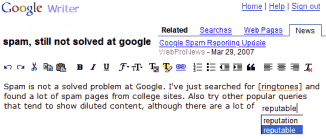
Google launched in October 2005 a feed reader, which became popular a year later. The company also offered publishing tools like Blogger, Page Creator and Google Docs, but even if they make your job easier by letting you focus on the content, you still have to come up with the text and the ideas.
Google Writer is a new application planned to be launched soon at Google Labs. It will integrate with many other Google services and guide you while writing a blog post, an essay or a news article.
Let's say you have a blog about Google, you wake up in the morning and wonder what to write. Now you can go to Google Writer, create a new project, enter some keywords and a small description and choose the default output (Blogger). Now when you create a new article inside this project, Google Writer gives you suggestions about the hot topics of the day, insightful articles about Google, news and popular queries that include "Google".
After choosing the topic, Google Writer suggests a title, some key quotes from other blogs and some interesting sites, images, and videos about the topic to facilitate your research. You can choose those that interests you and let Google Writer create some context around the quotes. Google Writer has a big database of n-grams from web pages and it's able to create grammatically-correct sentences. It also learns your writing style from the previous articles, it knows your favorite authors, sites and your interests.
Now that you have the basis of the article, Google Writer suggests some concepts or portions of the text you should write about or expand. Google Writer has a smart autocomplete that learns from the web and is adapted to your style. It's also able to summarize text, to show interesting content from the web related to a text fragment and previous articles on the same topic.
At launch, the tool will only support Internet Explorer and Firefox, and will be invitation-only. Google intends to expand the tool for other online activities like sending mail, instant messaging, so you can dedicate more time to other important things, like writing cool applications. I asked Google if the creativity will disappear with tools like this that build a text on top of some aggregated fragments, but I only got a strange mail:
"The secret to creativity is knowing how to hide your sources.
powered by Google Writer"
The Viral Marketing of an April Fools Launch
Probably the best press release written by Google was on April 1st 2004, when Google launched Gmail.
Launching a product on April 1st had its risks (most people thought it was a hoax) and its advantages (the hoax turned out to be a real mail service, so real that some wanted to pay to get a Gmail address), but it was an excellent viral marketing. From CNN Money:
Google made fun of its search technology, the contextual ad system, their work environment and products. What do you think they'll do this year?
MOUNTAIN VIEW, Calif. - April 1, 2004 UTC - Amidst rampant media speculation, Google Inc. today announced it is testing a preview release of Gmail – a free search-based webmail service with a storage capacity of up to eight billion bits of information, the equivalent of 500,000 pages of email. Per user.
The inspiration for Gmail came from a Google user complaining about the poor quality of existing email services, recalled Larry Page, Google co-founder and president, Products. "She kvetched about spending all her time filing messages or trying to find them," Page said. "And when she's not doing that, she has to delete email like crazy to stay under the obligatory four megabyte limit. So she asked, 'Can't you people fix this?'"
Launching a product on April 1st had its risks (most people thought it was a hoax) and its advantages (the hoax turned out to be a real mail service, so real that some wanted to pay to get a Gmail address), but it was an excellent viral marketing. From CNN Money:
Google's one gigabyte of storage claim led to some speculation about the Gmail announcement being a hoax since it took place on April Fool's Day. Google has pulled April Fool's jokes on the tech community before, including jokes about pigeons being the driving force behind Google's search technology and that Google was looking to start a new research center on the moon.
In addition, the press release about Gmail was fairly goofy(...). But Jonathan Rosenberg, vice president of the products group at Google, said the Gmail announcement was legitimate. He did concede that the company did get caught up in the spirit of April Fool's Day in its press release.
Google made fun of its search technology, the contextual ad system, their work environment and products. What do you think they'll do this year?
Google as a Symbol of Excellence
When you want to say that a company is a leader in a field or has the best products, you say it's the Google of that field. If you search for "* is the Google of *", you'll find a lot of services and companies compared to Google.
* Krugle is the Google of programming code
* Baidu is the Google of China
* YouTube is the Google of Video
* Michael Arrington is the Google of Web 2.0 (?!)
* Gamespot is the Google of Videogames
* Nero is the Google of burning software
* Winamp is the Google of MP3 players
* Technorati is the Google of blog searching
* Flickr is the Google of photo sharing
* Bloglines is the Google of RSS readers
* Amazon is the Google of online book retailers
* ImageShack is the Google of free image hosting
* TailRank is the Google of memetrackers
* Skype is already the Google of VoIP
* Pandora is the Google of music
* Honda is the Google of automakers
* imdb is the Google of movies
* MySpace is the Google of social networks
* iTunes is the Google of the podcasting world
* Lonely Planet is the Google of guidebooks
{ Idea from a post written by Chris DiBona. }
* Krugle is the Google of programming code
* Baidu is the Google of China
* YouTube is the Google of Video
* Michael Arrington is the Google of Web 2.0 (?!)
* Gamespot is the Google of Videogames
* Nero is the Google of burning software
* Winamp is the Google of MP3 players
* Technorati is the Google of blog searching
* Flickr is the Google of photo sharing
* Bloglines is the Google of RSS readers
* Amazon is the Google of online book retailers
* ImageShack is the Google of free image hosting
* TailRank is the Google of memetrackers
* Skype is already the Google of VoIP
* Pandora is the Google of music
* Honda is the Google of automakers
* imdb is the Google of movies
* MySpace is the Google of social networks
* iTunes is the Google of the podcasting world
* Lonely Planet is the Google of guidebooks
{ Idea from a post written by Chris DiBona. }
March 30, 2007
Patent for Behavioral Targeted Ads in Games
After acquiring AdScape, a company that produces ads for video games, Google has a new patent that reveals some interesting ways of targeting ads to gamers.
Some context:
"In-game advertising is becoming extremely popular. This trend is expected to continue since the 18 to 34 year old male demographic in the U.S. is watching less TV and spending more time playing video games than ever before. The video game industry is becoming a media force on par with the television and motion picture industries. Consequently, ad agencies and game producers are collaborating to introduce more ads into video games. Presently, in-game ads are used to advertise real products and services in a manner analogous to product placement in movies and television shows. For example, a decal on a virtual race car may advertise a product or service. (...) Unfortunately, ads placed in various video games are typically determined while the game is developed and are therefore relatively static. Further, the ads are typically targeted to a broad demographic group. Consequently, in-game ads are often not as relevant and useful as they could be. "
The patent suggests a system that takes into account user's interaction with the game, its decisions and preferences.
Basically, you're living in a virtual world where your behavior is tracked and used to deliver ads that fill some predetermined spots. Behavioral targeted advertising is already used on the web by some ad networks, but the information that is tracked is much more limited (the sites you visit, the length of visit). In games, you have access to subtle details (game's choices could become a personality test). I wonder if gamers would accept such a system.
{via SEO by the Sea.}
Some context:
"In-game advertising is becoming extremely popular. This trend is expected to continue since the 18 to 34 year old male demographic in the U.S. is watching less TV and spending more time playing video games than ever before. The video game industry is becoming a media force on par with the television and motion picture industries. Consequently, ad agencies and game producers are collaborating to introduce more ads into video games. Presently, in-game ads are used to advertise real products and services in a manner analogous to product placement in movies and television shows. For example, a decal on a virtual race car may advertise a product or service. (...) Unfortunately, ads placed in various video games are typically determined while the game is developed and are therefore relatively static. Further, the ads are typically targeted to a broad demographic group. Consequently, in-game ads are often not as relevant and useful as they could be. "
The patent suggests a system that takes into account user's interaction with the game, its decisions and preferences.
The game play tracking operations may track game player input information. For instance, in most simulation games as in a Formula One racing game, a user may select a real world make/team of a car (e.g., Ferrari, Williams-BMW, McLaren-Mercedes, Renault, etc.), a particular driver (e.g., Michael Schumacher, Fernando Alonso, Rubens Barrichello, etc.) as well as the racing track desired to compete in (e.g., Monte Carlo/Monaco, Nurburgring/Europe, Indianapolis/USA, etc.), car color, type of tires, etc. (...) If a user selected a racing car from Dodge, the system may show a Dodge ad or something related.
Game state-based information may include information about the user's game-play. For example it may include, how fast the players are going through the levels, how familiar the players are with the game, what level are the players in (...), how long have the players been playing the game, how frequently the user plays various games, play-pause habits, game information stored to non-volatile memory, etc. (...) If the user has been playing for over two hours continuously, the system may display ads for pizza-hut, coke, coffee and other related goods.
The play characteristics of users, particularly in online RPG games (e.g., time spent chatting with other virtual players versus fighting, time spent bartering versus stealing, time spent exploring versus building, time spent trying new items versus completing levels, decisions made by players leading to certain situations (good versus bad, strategic versus short term), avoiding conflict (risk averse) versus being aggressive, cooperating and collaborating versus doing things alone, friendly versus hostile, etc.) may be particularly useful. User input information may be useful to help infer information about a user. Some other examples user information that may be inferred includes familiarity with a game(s), time spent playing a game(s), how fast is the user advancing and/or skill level, etc. Inferences drawn from such user input information may be made using known classification means such as neural networks, Bayesian networks, support vector machines, etc. Such inferred user information may be useful to help target ads. For instance, users that spend a long time bartering instead of stealing in a game may suggests that they are interested in the best deals rather than the flashiest items so the system may show ads reflecting value.
Basically, you're living in a virtual world where your behavior is tracked and used to deliver ads that fill some predetermined spots. Behavioral targeted advertising is already used on the web by some ad networks, but the information that is tracked is much more limited (the sites you visit, the length of visit). In games, you have access to subtle details (game's choices could become a personality test). I wonder if gamers would accept such a system.
{via SEO by the Sea.}
March 29, 2007
Google Maps Shows Funny Directions
It's not the first time when Google Maps shows strange directions. This time, if you want to go from Stanford to Stockholm, Google recommends to "swim across the Atlantic Ocean" (only 3,462 miles).
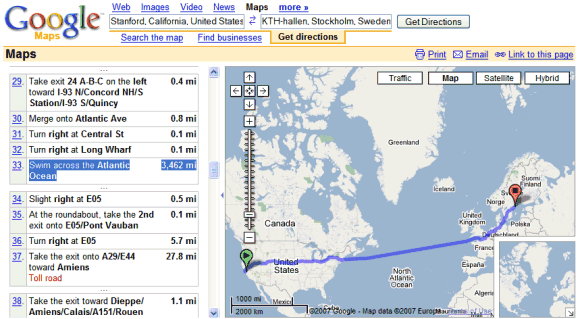
Last month, Google Maps transformed a short walk into a journey of 18 minutes. "For most people, the journey from the Shelbourne Hotel at 200 Sussex Street to Google's Sydney headquarters across the road at 201 Sussex Street would be a 30-step, 30-second trip. But according to Google's new mapping service, the recommended route would see you take a 10.4-kilometre scenic detour that involves crossing the Harbour Bridge twice," reported Sydney Morning Herald in February.
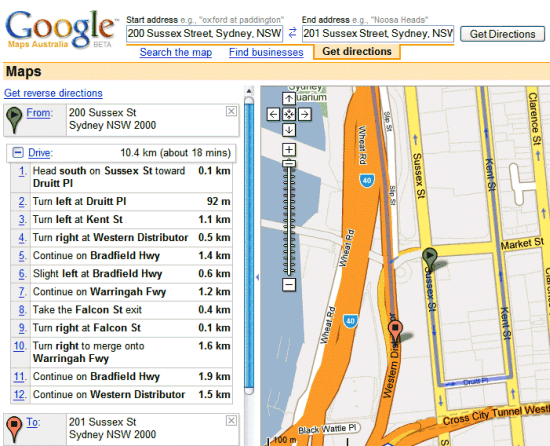
In January, Digg uncovered that you had to make a lot of U-turns to get from Bensalem to North Brunswick. It turned out that Google's driving direction engine had a bug that created an infinite loop.
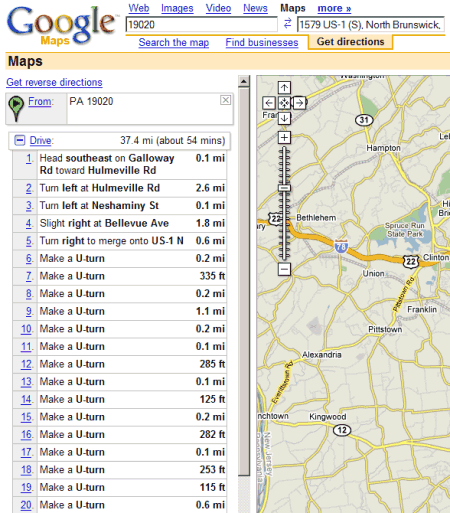
So next time take Google Maps' drive directions with a grain of salt.
{ via Blogoscoped }

Last month, Google Maps transformed a short walk into a journey of 18 minutes. "For most people, the journey from the Shelbourne Hotel at 200 Sussex Street to Google's Sydney headquarters across the road at 201 Sussex Street would be a 30-step, 30-second trip. But according to Google's new mapping service, the recommended route would see you take a 10.4-kilometre scenic detour that involves crossing the Harbour Bridge twice," reported Sydney Morning Herald in February.

In January, Digg uncovered that you had to make a lot of U-turns to get from Bensalem to North Brunswick. It turned out that Google's driving direction engine had a bug that created an infinite loop.

So next time take Google Maps' drive directions with a grain of salt.
{ via Blogoscoped }
API for Yahoo Mail
Yahoo launched a web service for Yahoo Mail that will allow developers to build applications around users' mail accounts.
Unfortunately, most of the applications that use the new API will be available only to Yahoo Mail Plus users. But the developers have a reason to be happy: if they build something exciting enough to convince users to pay for Yahoo Mail Plus, they'll get $10 for each user.
A simple example that works with any Yahoo Mail account is Flickr Association that displays Flikr images related to your messages.
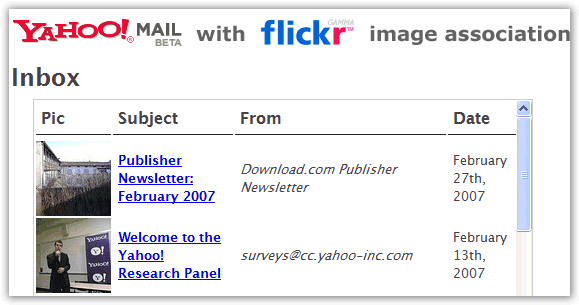
We are thrilled to announce the open availability of the Yahoo! Mail Web Service, web service for Yahoo! Mail (accessible via SOAP or JSON-RPC) that we previewed to Yahoo! Hack Day attendees. With the Yahoo! Mail Web Service, you can connect to the core mail platform to perform typical mailbox tasks for premium users such as list messages and folders, and compose and send messages (you can also build mail preview tools for free users with limited Web Service functionality). In other words, developers outside of Yahoo! can now build mail tools or applications on the same infrastructure we use to build the highly-scaled Yahoo! Mail service that serves nearly 250 million Yahoo! Mail users today.
Unfortunately, most of the applications that use the new API will be available only to Yahoo Mail Plus users. But the developers have a reason to be happy: if they build something exciting enough to convince users to pay for Yahoo Mail Plus, they'll get $10 for each user.
A simple example that works with any Yahoo Mail account is Flickr Association that displays Flikr images related to your messages.

March 28, 2007
Stylish New Design in Google Notebook
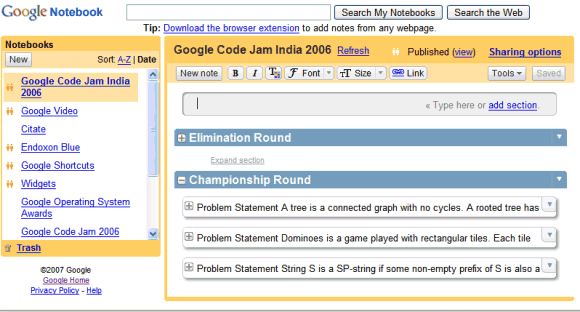
Google Notebook has a new UI that uses AJAX a lot (here's the old one, for reference). "After a long slog, our sexy new version of Google Notebook is out. There are still bugs and things missing, but I think this version is a lot more fun than the old one," says Kushal Dave on his blog.
You can see all your notebooks in the sidebar, ordered alphabetically or by modified date. It's easier to add notes: just click in the space between any existing notes. Google Notebook borrowed the layout of messages from Gmail and placed the editing buttons at the top of the page so you don't feel any disruptive interface change when you edit a note. You can now add comments to notebooks and remove the title and the URL of a clipped note. Google auto-saves each note, so you don't have to press a "Save" button.
If you add notes from Google Maps and publish the notebook, you'll have an option to see the places on a map.
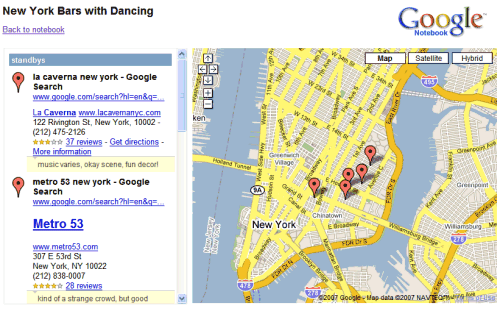
The mini-notebook, available as an add-on/extension, has a similar look:
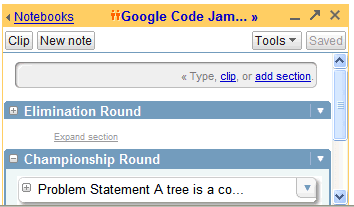
The option to search public notebooks has been removed (but you can use Google search to do that), Google Notebook looks faster because of the heavy AJAX usage, and the product graduated from Google Labs. Overall, a nice face-lifting, even though users were expecting to see other features like tags or file attachments.
{ Thanks, C. I. R. E. }
Google Beta - Imagine a New Search Engine

Google's logo in 1999
Forget about the layout of most search engines, forget about the top 10 results, forget about different interfaces for images, news, maps, videos. Imagine that Google starts from the beginning, puts the beta sign next to the logo and reinvents itself.
Soon you might be invited to try an experimental version of Google search. It may be SearchMash, but I'm sure it's much more than that.
How would you imagine a search engine if you tried to ignore everything you've seen before?
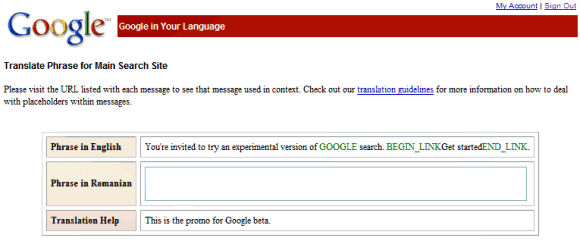 "Phrase in English: You're invited to try an experimental version of GOOGLE search.
"Phrase in English: You're invited to try an experimental version of GOOGLE search.Translation Help: This is the promo for Google beta."
This is a screenshot from "Google in Your Language", a program in which you can translate Google's services in different languages. The messages show up in "Google in Your Language" before they're live at google.com, so they may indicate new features or products.
LG Phones to Preinstall Google Software
While the Google Phone rumor continues to persist, Google execs said they intend to focus on creating software for mobile phones and making sure the software reaches the users.
A new distribution partner is LG, the #5 mobile phone maker in the world. "LG handsets with Google products and services, such as Google Maps, Gmail and Blogger, will be shipped to North America, Europe and Asia starting in the second quarter of 2007, the companies said. LG (...) plans to release at least 10 new handset models with the Google products in 2007 and continue offering them for the next few years," according to Reuters.
Yahoo managed to pack the most popular services into Yahoo Go, a sleek application that wants to become a one-stop shop for browsing the web. It combines the new mobile search engine from Yahoo with mail, maps, news, finance, photo sharing. The software is or will be preinstalled in a lot of phones from Nokia and Samsung, but also in a small number of phones from Motorola and LG. It looks like Yahoo has a much better mobile strategy than Google.
Here's the situation in the PC bundle world:
A new distribution partner is LG, the #5 mobile phone maker in the world. "LG handsets with Google products and services, such as Google Maps, Gmail and Blogger, will be shipped to North America, Europe and Asia starting in the second quarter of 2007, the companies said. LG (...) plans to release at least 10 new handset models with the Google products in 2007 and continue offering them for the next few years," according to Reuters.
Yahoo managed to pack the most popular services into Yahoo Go, a sleek application that wants to become a one-stop shop for browsing the web. It combines the new mobile search engine from Yahoo with mail, maps, news, finance, photo sharing. The software is or will be preinstalled in a lot of phones from Nokia and Samsung, but also in a small number of phones from Motorola and LG. It looks like Yahoo has a much better mobile strategy than Google.
| Company | Share (Q4 2005) | Share (Q4 2006) | Partners |
| Nokia | 34.1 | 35.2 | Yahoo |
| Motorola | 18.2 | 21.9 | Yahoo and Google |
| Samsung | 11.1 | 10.7 | Yahoo and Google |
| Sony Ericsson | 6.6 | 8.7 | Google |
| LG | 6.6 | 5.7 | Yahoo and Google |
Here's the situation in the PC bundle world:
| Company | Share (Q4 2005) | Share (Q4 2006) | Partners |
| HP | 15 | 17.4 | Yahoo |
| Dell | 16.4 | 14.5 | |
| Lenovo | 7 | 7.1 | Microsoft |
| Acer | 5.5 | 6.6 | Yahoo |
| Toshiba | 3.3 | 3.7 | |
Yahoo Mail, with Unlimited Storage
Yahoo Blog announces that Yahoo Mail will have unlimited storage. They'll be rolling this out over a few months, starting from May.
The official explanation is that the cost of storage dropped and users send more attachments. "We have been closely monitoring average usage. We are comfortable that our users are far under 1 gig(abyte), on average. What we see are an increasing number of rich media files as consumers send more photos."
They even offer a history of Yahoo Mail, in terms of storage, but here's the real timeline:
1997
October 8: Yahoo acquires Rocketmail and transforms it into Yahoo Mail. Storage size: 3 MB, that will soon become 4 MB.
2004
April 1: Gmail launches with 1 GB of free storage (invitation-only)
June 15: Yahoo Mail upgrades to 100 MB. Yahoo buys OddPost next month to make the first important UI transformation.
2005
April 1: Gmail doubles the storage: 2 GB. They also launch the Infinity+1 storage plan: each day the storage increases with a small quota (that dropped from 3.456 MB at that time to 0.33 MB now).
Late April: Yahoo Mail has 1 GB.
Of course that very few people have gigabyte-sized mailboxes and this is more like a marketing gimmick, but Yahoo's announcement marks the first time since Gmail launch when Yahoo Mail makes the first move and is about to become better than the competition. We'll have to wait and see if Sergey Brin changes his mind and amends the plan that Google "will start selling additional storage capacity to e-mail users with extraordinary needs".
Meanwhile, Gmail had serious performance problems at least three times this month, mostly for Google Apps users. "All three incidents this month have affected an undetermined subset of Google Apps users, including those on the Premier version of the suite, who pay a fee that grants them a service-level commitment from Google of 99.99 percent uptime."
{ Thank you, Nimish. }
The official explanation is that the cost of storage dropped and users send more attachments. "We have been closely monitoring average usage. We are comfortable that our users are far under 1 gig(abyte), on average. What we see are an increasing number of rich media files as consumers send more photos."
They even offer a history of Yahoo Mail, in terms of storage, but here's the real timeline:
1997
October 8: Yahoo acquires Rocketmail and transforms it into Yahoo Mail. Storage size: 3 MB, that will soon become 4 MB.
2004
April 1: Gmail launches with 1 GB of free storage (invitation-only)
June 15: Yahoo Mail upgrades to 100 MB. Yahoo buys OddPost next month to make the first important UI transformation.
2005
April 1: Gmail doubles the storage: 2 GB. They also launch the Infinity+1 storage plan: each day the storage increases with a small quota (that dropped from 3.456 MB at that time to 0.33 MB now).
Late April: Yahoo Mail has 1 GB.
Of course that very few people have gigabyte-sized mailboxes and this is more like a marketing gimmick, but Yahoo's announcement marks the first time since Gmail launch when Yahoo Mail makes the first move and is about to become better than the competition. We'll have to wait and see if Sergey Brin changes his mind and amends the plan that Google "will start selling additional storage capacity to e-mail users with extraordinary needs".
Meanwhile, Gmail had serious performance problems at least three times this month, mostly for Google Apps users. "All three incidents this month have affected an undetermined subset of Google Apps users, including those on the Premier version of the suite, who pay a fee that grants them a service-level commitment from Google of 99.99 percent uptime."
{ Thank you, Nimish. }
March 27, 2007
Google Screensaver
Update: The screensaver is now a Picasa feature. You can download Picasa from picasa.google.com.
Google Screensaver is a Windows screensaver that displays photos from different locations:
The screensaver acts like a slideshow so you can move to the next/previous photo using the mouse. The title and the author of a photo is always visible and you can go to the source of the photo by clicking to one of the links from the bottom of the window.
You can configure the visual effects (collage, wipe, pan and zoom, cross fade) and how often the photos change.
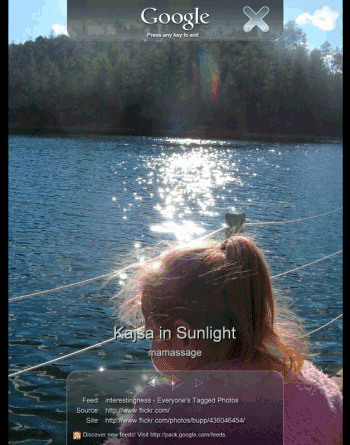
The screensaver is a part of Google Pack, but if you get it from this page you can install only the screensaver. Then you can uninstall Google Updater and keep the screensaver.
Update. You can download Google Screensaver without installing Google Pack (this link may change in the future):
gpdl.google.com/installers/ci_ss/en/2.2007.0412.1728/gpscrsav.msi (4.5 MB).
Google Screensaver is a Windows screensaver that displays photos from different locations:
- Your computer. You select a list of folders that contain photos and Google Screensaver monitors the JPEGs from these folders.
- Picasa Web Albums. If you use Google's photo sharing site, you can view pictures from the most recently modified albums and from your contacts. It's probably the most interesting feature of Picasa Web Albums: you can monitor all the photos uploaded to your contacts' albums.
- Web feeds. You can find them in photo sharing sites like Flickr, Picasa Web Albums or at this page. Some nice feeds: Flickr (Vista wallpapers, nature, architecture, landscape, Google food), Yahoo search (autumn, Dali, sunset) . To add a new source, right-click a link to a feed in IE and Firefox and select "Add to Google Photos Screensaver".
The screensaver acts like a slideshow so you can move to the next/previous photo using the mouse. The title and the author of a photo is always visible and you can go to the source of the photo by clicking to one of the links from the bottom of the window.
You can configure the visual effects (collage, wipe, pan and zoom, cross fade) and how often the photos change.

The screensaver is a part of Google Pack, but if you get it from this page you can install only the screensaver. Then you can uninstall Google Updater and keep the screensaver.
Update. You can download Google Screensaver without installing Google Pack (this link may change in the future):
gpdl.google.com/installers/ci_ss/en/2.2007.0412.1728/gpscrsav.msi (4.5 MB).
The New Google Mobile Search
One week ago, Yahoo released a new interface for mobile search (available at m.yahoo.com) that focused on showing more local information, more direct answers, and less links. Now Google responds and launches a new version of Google Mobile Search.
The new site is location-aware, so you have an option to enter your location, so you get results related to where you are.
You can now create a mobile version for the personalized homepage right from your phone. Unfortunately, the list of options is limited to weather, stocks, movies and a list of popular news sites. But the good news is that the weather and movie listings are restricted to your location, which can be easily changed.
Because you've already told Google your location, you don't have to enter it each time you search. Here's a comparison between the old version of mobile search and the new one, for the query "pizza". Google shows 6 web results instead of 10 and the focus in on the business listings, which are targeted to my location.
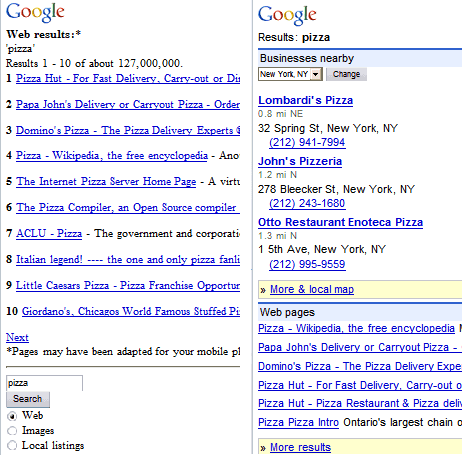
You don't have to specify the type of search (local listings, for example), because the structure of the results is query-dependent. For some queries, you'll see image results or news articles at the top; for others, you'll see local results or only web results. Each section of search results can be expanded.
Another improvement can be found in web search results. Google optimizes the pages for mobile and splits them so you can easily read them on your mobile phone (that's not new), but now it sends you directly to the section that's most relevant to your query, highlights the query in the page, creates a table of contents for some of the pages and shows a link to the feed, so you can read it in Google Reader. That's pretty impressive.
If I search for "tea house google theme" and click on the result from Google Operating System, I'll read only the most relevant section of the page.
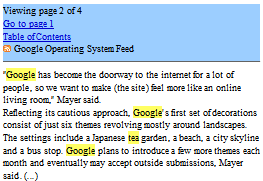
If you have a clever phone that knows how to handle web pages, you can deactivate Google's transcoder in the settings.
Google removed the option to search only mobile-optimized pages and merged them with the standard web pages. You'll notice that pages written for mobile phones have a small phone icon next to them in the search results.
All in all, there's an improvement. People can find more information relevant to them with fewer clicks (especially if they're in the US), but Google could have added unit conversations, mathematical calculations, facts, sport results, traffic information etc. For now, simple queries like "13*3.14" or "Italy population" don't return the right answer.
Google Mobile Search is available at google.com/m, although entering google.com into your mobile phone should work as well. You should see a link to try the new version at the top of the page.
Update: Here's a page where you can compare the old and the new version of Google Mobile Search with Yahoo Mobile Search and Windows Live.
The new site is location-aware, so you have an option to enter your location, so you get results related to where you are.
You can now create a mobile version for the personalized homepage right from your phone. Unfortunately, the list of options is limited to weather, stocks, movies and a list of popular news sites. But the good news is that the weather and movie listings are restricted to your location, which can be easily changed.
Because you've already told Google your location, you don't have to enter it each time you search. Here's a comparison between the old version of mobile search and the new one, for the query "pizza". Google shows 6 web results instead of 10 and the focus in on the business listings, which are targeted to my location.

You don't have to specify the type of search (local listings, for example), because the structure of the results is query-dependent. For some queries, you'll see image results or news articles at the top; for others, you'll see local results or only web results. Each section of search results can be expanded.
Another improvement can be found in web search results. Google optimizes the pages for mobile and splits them so you can easily read them on your mobile phone (that's not new), but now it sends you directly to the section that's most relevant to your query, highlights the query in the page, creates a table of contents for some of the pages and shows a link to the feed, so you can read it in Google Reader. That's pretty impressive.
If I search for "tea house google theme" and click on the result from Google Operating System, I'll read only the most relevant section of the page.

If you have a clever phone that knows how to handle web pages, you can deactivate Google's transcoder in the settings.
Google removed the option to search only mobile-optimized pages and merged them with the standard web pages. You'll notice that pages written for mobile phones have a small phone icon next to them in the search results.
All in all, there's an improvement. People can find more information relevant to them with fewer clicks (especially if they're in the US), but Google could have added unit conversations, mathematical calculations, facts, sport results, traffic information etc. For now, simple queries like "13*3.14" or "Italy population" don't return the right answer.
Google Mobile Search is available at google.com/m, although entering google.com into your mobile phone should work as well. You should see a link to try the new version at the top of the page.
Update: Here's a page where you can compare the old and the new version of Google Mobile Search with Yahoo Mobile Search and Windows Live.
Google by SMS
Google SMS is a service that lets you send queries to Google by SMS and get back short answers. It only works in the US and Canada, Germany, Japan and Spain.
You can use it to get standard results by adding "g" in front of your query, but this service should be used for queries that usually return an OneBox, like stock quotes, weather in a certain city, currency conversions, price of a product or local results. Google has recently added real-time flight info so you can just text the name of a US flight and find the time of the departure. Or text the name of a airlines company to find its phone number. The service is optimized for mobile phones, so there are shortcuts for common words like "weather".
Google SMS was launched in 2004:
You can use it to get standard results by adding "g" in front of your query, but this service should be used for queries that usually return an OneBox, like stock quotes, weather in a certain city, currency conversions, price of a product or local results. Google has recently added real-time flight info so you can just text the name of a US flight and find the time of the departure. Or text the name of a airlines company to find its phone number. The service is optimized for mobile phones, so there are shortcuts for common words like "weather".
Google SMS was launched in 2004:
SMS stands for Short Message Service, and Europe and Asia have thoroughly embraced this text messaging technology. Using your phone to send and receive text messages is a newer phenomenon in the U.S. Now we're getting into the fray with Google SMS. It's a way to access Google for precise information from your mobile phone or handheld device (like a BlackBerry).
March 26, 2007
Toll Roads in Google Maps
Google Maps includes information about toll roads (roads where you have to pay a fee), at least for the US. Chris Maloy, who sent me the tip, says:
"This has been long been missing from Google, but available on most other map services. I like seeing this on the detail, however it would be nice to have on as an indicator on the map, or where the toll booth is (helpful for long toll roads), and finally the cost of the toll."
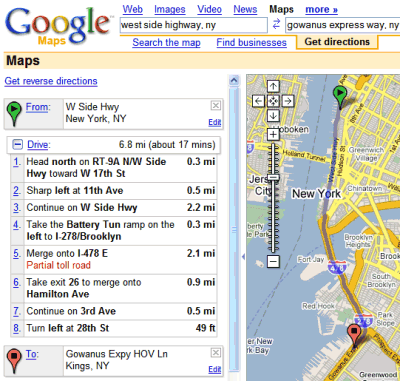
"This has been long been missing from Google, but available on most other map services. I like seeing this on the detail, however it would be nice to have on as an indicator on the map, or where the toll booth is (helpful for long toll roads), and finally the cost of the toll."

Why People Link to Wikipedia

The main reason behind Wikipedia's high ranking in Google search is that people link to Wikipedia articles. It may seem strange that people choose to link to Wikipedia instead of other sites, but the "free encyclopedia that anyone can edit" has many selling points:
1. Wikipedia articles have a lot of content and people like to link to pages that consist mostly on text. There's a lot of information structured in a consistent way and that makes most of the articles valuable.
2. Wikipedia articles have an accessible language. Even if you're not familiar with a domain, you can understand the basic things and it's easy to learn more.
3. Why shall I link to the Wikipedia page for "Ask a Ninja" instead of the homepage of the videoblog? Because the Wikipedia page start with "Ask A Ninja is an award-winning series of comedy videos about the image of ninjas in popular culture", while the homepage shows the latest videos. There's more context in Wikipedia.
4. Wikipedia pages are more objective than other sites because they don't try to sell products or ideas, they only explain what is all about and include criticism. Another selling point is that Wikipedia doesn't have ads.
5. A Wikipedia article is constantly updated, so you can say it's never finished. You're more likely to link to a page that will be still fresh next year.
6. Wikipedia is already familiar to many people, so you treat as and old friend that has answers for most of your questions. You don't trust other sites enough to link to them, it's hard to decide which one deserves this honor, so you link to Wikipedia.
7. You treat Wikipedia as a free-style dictionary that has entries for a lot of things. So when you need to explain something you link to the extended dictionary.
8. If you link to a Wikipedia article, you don't need to link to other sites because the external links from that article are very good or at least good enough.
9. You've already found a lot of interesting things from Wikipedia so you tend to trust it and recommend it to others.
10. Wikipedia pages compile a lot of disparate information from different sites, so they're a good reference point for someone who wants an overview on a topic.
Resize Google Personalized Homepage's Columns
In case you want to tweak the width of IGoogle's columns, this Greasemonkey script is pretty good. It's easy to adjust the width of the columns in each tab, but the settings are only saved locally. That means you'll see the customized columns only if you use the same browser on the same computer. Maybe a column resizing gadget would be a better idea.
To install it, you need Greasemonkey for Firefox.
Note: If you use a localized version of Google, after installing the script, go to Tools/ Greasemonkey/ Manage user scripts, select "Google Homepage Resizeable Column" and click "Edit". Replace "http://www.google.com/ig?hl=en" with "http://www.google.*/ig*" (remove the quotes).
To install it, you need Greasemonkey for Firefox.
Note: If you use a localized version of Google, after installing the script, go to Tools/ Greasemonkey/ Manage user scripts, select "Google Homepage Resizeable Column" and click "Edit". Replace "http://www.google.com/ig?hl=en" with "http://www.google.*/ig*" (remove the quotes).
YouTube Awards - The Winners
These are the best videos created by YouTube users in 2006. The competition is over and you can see the winners in a playlist created using SplashCast.
Most Creative / People dancing on treadmills. Music: "Here It Goes Again" by OK Go.
Best Comedy / Smosh Short. A man finds himself stranded on a deserted island. Smosh probably has a lot of fans.
Best Commentary / Hotness Prevails. The Wine Kone complains about heat, stereotypes and heat.
Best Series / Ask a Ninja. A series created by Kent Nichols and Douglas Sarine that features a ninja who answers questions received by email. "Ninja is known for his emphatic declarations, as well as his expansive, spontaneous, and often extremely exaggerated hand gestures (helpful in communicating his comedic intent, as one can only see his eyes)."
Best Music Video / A beautiful song played by a talented girl. Another MySpace star.
Most Inspirational / Free Hugs Campaign. Random acts of kindness. People deliberately hugging strangers.
Most Adorable - Kiwi, a short film by Dony Permedi, about a bird that can't fly, but "spends its whole life working towards achieving his dream. The kiwi strived to create the illusion that it was flying over a forest as it soared down through the sky from the top of a cliff. Thus, the kiwi spent what must have been its whole life nailing trees to the side of a cliff. All this, to fulfill its one dream of flying, even though it was technically unable to." Read an interview with its creator.
Most Creative / People dancing on treadmills. Music: "Here It Goes Again" by OK Go.
Best Comedy / Smosh Short. A man finds himself stranded on a deserted island. Smosh probably has a lot of fans.
Best Commentary / Hotness Prevails. The Wine Kone complains about heat, stereotypes and heat.
Best Series / Ask a Ninja. A series created by Kent Nichols and Douglas Sarine that features a ninja who answers questions received by email. "Ninja is known for his emphatic declarations, as well as his expansive, spontaneous, and often extremely exaggerated hand gestures (helpful in communicating his comedic intent, as one can only see his eyes)."
Best Music Video / A beautiful song played by a talented girl. Another MySpace star.
Most Inspirational / Free Hugs Campaign. Random acts of kindness. People deliberately hugging strangers.
Most Adorable - Kiwi, a short film by Dony Permedi, about a bird that can't fly, but "spends its whole life working towards achieving his dream. The kiwi strived to create the illusion that it was flying over a forest as it soared down through the sky from the top of a cliff. Thus, the kiwi spent what must have been its whole life nailing trees to the side of a cliff. All this, to fulfill its one dream of flying, even though it was technically unable to." Read an interview with its creator.
March 25, 2007
Is JotSpot Google's Glue?
Many people wondered why Google bought JotSpot, a wiki company. After all, JotSpot let you create and share documents, spreadsheets, calendars, photos, videos and more. Google already has different services for most of these types of files, but they aren't integrated (or the integration is very limited).
Guillaume Belfiore suggests that JotSpot could integrate all the communication services created by Google into a single interface - let's call it GDrive. "In the end, many existing Google services would be accessible in one place. To me it is pretty obvious that, should GDrive become true one day, it will make an extensive use of the JotSpot technology," says Guillaume.
To get an idea, visit this gallery from JotSpot that shows applications for their free-form wiki model ("everything is a wiki"):
* spreadsheets (think Google Spreadsheets)
* blogs (Blogger)
* forums (Google Groups)
* mail (Gmail)
* calendar (Google Calendar)
* photo gallery (Picasa Web Albums)
* and more (project manager, to-do lists, file cabinet, knowledge base)
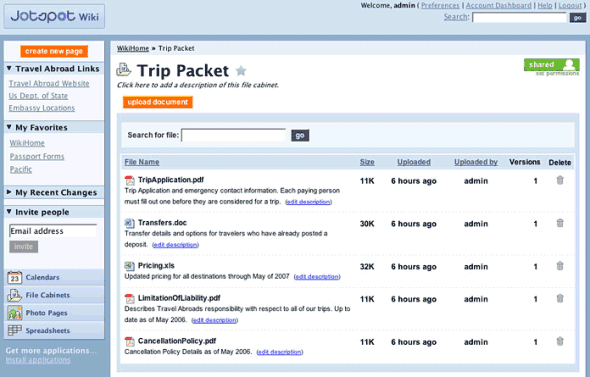
Here's what Scott Johnston from JotSpot says about this:
"At Google we will continue to realize our vision of collaborative applications built on an integrated development platform."
Guillaume Belfiore suggests that JotSpot could integrate all the communication services created by Google into a single interface - let's call it GDrive. "In the end, many existing Google services would be accessible in one place. To me it is pretty obvious that, should GDrive become true one day, it will make an extensive use of the JotSpot technology," says Guillaume.
To get an idea, visit this gallery from JotSpot that shows applications for their free-form wiki model ("everything is a wiki"):
* spreadsheets (think Google Spreadsheets)
* blogs (Blogger)
* forums (Google Groups)
* mail (Gmail)
* calendar (Google Calendar)
* photo gallery (Picasa Web Albums)
* and more (project manager, to-do lists, file cabinet, knowledge base)

Here's what Scott Johnston from JotSpot says about this:
"At Google we will continue to realize our vision of collaborative applications built on an integrated development platform."
More Google Keyboard Shortcuts
Amit Agarwal found a new keyboard shortcut in Gmail. To delete a mail, you just have to press # (or Shift+3). To use this and other Gmail keyboard shortcuts, you'll have to enable them in the settings.
Another interesting shortcut, this time for Google Reader, is ?. If you type the question mark, Google Reader shows a nice panel of shortcuts. You have no excuse not to use them.
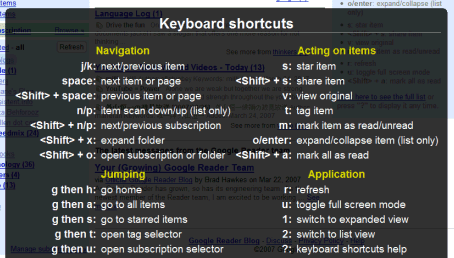
It's so easy to send a mail in Google Talk. Just type the first letter from the contact's name or email address in the input box, make sure the contact is selected, and press F9. You can also press F11 to initiate a call and F12 to end the call.
These keyboard shortcuts save you time, but also make you feel more in-the-know.
Related:
Learning Google's keyboard shortcuts
Shortcuts for Google Search
Enable copy-paste in Google Docs (Firefox-only)
Another interesting shortcut, this time for Google Reader, is ?. If you type the question mark, Google Reader shows a nice panel of shortcuts. You have no excuse not to use them.

It's so easy to send a mail in Google Talk. Just type the first letter from the contact's name or email address in the input box, make sure the contact is selected, and press F9. You can also press F11 to initiate a call and F12 to end the call.
These keyboard shortcuts save you time, but also make you feel more in-the-know.
Related:
Learning Google's keyboard shortcuts
Shortcuts for Google Search
Enable copy-paste in Google Docs (Firefox-only)
Google Docs to Add Support for Wikis
Google Spreadsheets has released a new version: 1.2.0i (even though you don't see them, every Google service has versions. In Google Spreadsheets you can actually see the current version in the bottom right corner of the window). The changes are mostly performance-related. They fixed some problems that caused some spreadsheets to not load or to not load fast enough. Google Spreadsheets added a new export format: txt for tab-separated values.
But the exciting things are yet to come in Google Docs & Spreadsheets. Google works for quite some time on adding charts to spreadsheets. After the JotSpot acquisition, the immediate results will be documents and spreadsheets editable by anyone. Here are some quotes from a JavaScript file that includes Google Docs messages like:
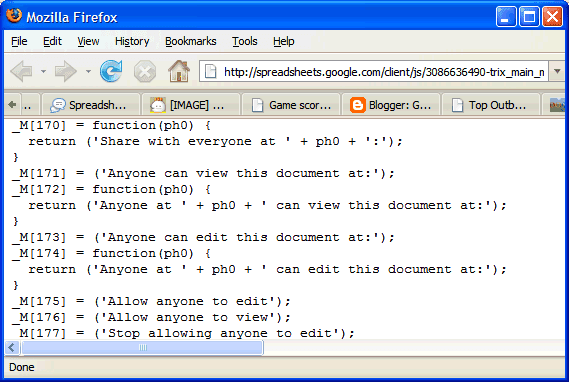
As defined by JotSpot, "a wiki is a private website designed for collaboration. Unlike a traditional website where pages can only be read, in a wiki everyone can edit, update and append pages with new information, all without knowing HTML." The most well-known wiki is Wikipedia, the encyclopedia that anyone can edit, but Wikipedia's rich-text editors are primitive.
It will be interesting to see if Google wikis will be available in community sites like orkut, Google Groups or even Blogger, and if Google tries to build its own knowledge wiki.
But the exciting things are yet to come in Google Docs & Spreadsheets. Google works for quite some time on adding charts to spreadsheets. After the JotSpot acquisition, the immediate results will be documents and spreadsheets editable by anyone. Here are some quotes from a JavaScript file that includes Google Docs messages like:
'Share with everyone:'
'Share with everyone at ' + ph0 + ':'
'Anyone can view this document at:'
'Anyone at ' + ph0 + ' can view this document at:'
'Allow anyone to edit'

As defined by JotSpot, "a wiki is a private website designed for collaboration. Unlike a traditional website where pages can only be read, in a wiki everyone can edit, update and append pages with new information, all without knowing HTML." The most well-known wiki is Wikipedia, the encyclopedia that anyone can edit, but Wikipedia's rich-text editors are primitive.
It will be interesting to see if Google wikis will be available in community sites like orkut, Google Groups or even Blogger, and if Google tries to build its own knowledge wiki.
March 24, 2007
Link to a Page Using Google AJAX Search
How many times did you post something in a blog or in a forum, but felt you need to add a link that explains a concept or a link to the homepage of a product? Laurence Gonsalves from Google used Google AJAX Search to create a bookmarklet that performs a search for the selected text from a form and lets you insert a link to one of the top search results for that query.
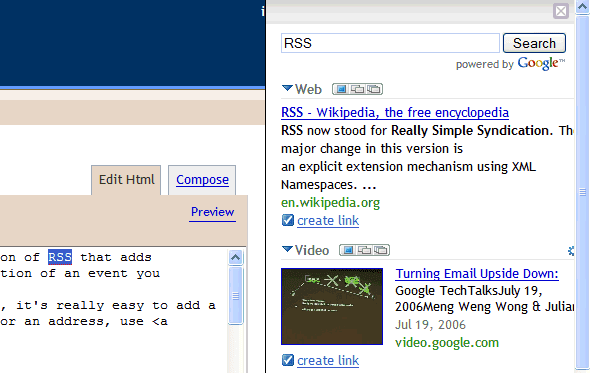
The bookmarklet seems to work only in Firefox and Opera. You just have to drag the link to your bookmarks toolbar. (Make sure the bookmarks toolbar is visible in your browser. You can make it visible if you go to View/Toolbars and enable Bookmarks Toolbar in Firefox or Personal Bar in Opera. Alternatively, you can just bookmark the link.)
Then everytime you need to quickly add a link in a textarea, type a text that will become both the query and the anchor text, select it, click on "Linkify" in your toolbar and then click on "Create a link" in the Google AJAX search sidebar.
You can use it when you post a comment to a blog, when you write a blog post or in other situations when you write in a textarea. Unfortunately it doesn't work with Gmail or Google Docs & Spreadsheets.

The bookmarklet seems to work only in Firefox and Opera. You just have to drag the link to your bookmarks toolbar. (Make sure the bookmarks toolbar is visible in your browser. You can make it visible if you go to View/Toolbars and enable Bookmarks Toolbar in Firefox or Personal Bar in Opera. Alternatively, you can just bookmark the link.)
Then everytime you need to quickly add a link in a textarea, type a text that will become both the query and the anchor text, select it, click on "Linkify" in your toolbar and then click on "Create a link" in the Google AJAX search sidebar.
You can use it when you post a comment to a blog, when you write a blog post or in other situations when you write in a textarea. Unfortunately it doesn't work with Gmail or Google Docs & Spreadsheets.
March 23, 2007
Google Maps Adds Support for GeoRSS
GeoRSS is an extension of RSS that adds geographic data. You can use it to clearly state the location of an event you describe in a blog post. As you can see in this example, it's really easy to add a GeoRSS tag to a feed. To get the latitude and longitude for an address, use Address Fix.
There's also a nice RSS to GeoRSS converter that identifies locations in a feed and transforms them into geographical coordinates. Here's how to use it:
http://ws.geonames.org/rssToGeoRSS?feedUrl=[RSS feed URL]
Example: Reuters World News
The reason for this talk about GeoRSS is that Google Maps started to support this format. Yahoo Maps is already using GeoRSS for data overlay; so does Virtual Earth. Google has been using KML, a format created by Keyhole, the company that developed Google Earth.
Here are the Reuters World News, some Flickr bird photos and a travel blog on Google Maps. As you can see, it's so easy to create mashups from a simple feed.
There's also a nice RSS to GeoRSS converter that identifies locations in a feed and transforms them into geographical coordinates. Here's how to use it:
http://ws.geonames.org/rssToGeoRSS?feedUrl=[RSS feed URL]
Example: Reuters World News
The reason for this talk about GeoRSS is that Google Maps started to support this format. Yahoo Maps is already using GeoRSS for data overlay; so does Virtual Earth. Google has been using KML, a format created by Keyhole, the company that developed Google Earth.
We now support GeoRSS as a data format for geographic content in Google Maps. We want to enable users to create data in whatever format is most convenient for them, and feel that by supporting both KML and GeoRSS we can enable a wider variety of people and applications to contribute content to Google Maps. We've built support for the Simple, GML, and W3C Geo encodings of GeoRSS -- all you have to do is enter the full URL of a GeoRSS file into the Maps query box to load the file. (...)
Most importantly, we've extended support for displaying geographic data -- both KML and GeoRSS -- into the Google Maps API. Now in addition to programatically adding content to a Maps API site, you can create your content as KML or GeoRSS and load it into the Map with a simple function call.
Here are the Reuters World News, some Flickr bird photos and a travel blog on Google Maps. As you can see, it's so easy to create mashups from a simple feed.
Google Tests a New Design for the Homepage
It wouldn't be the first time when Google tests new designs for the (classic) homepage or the search results pages, but this time someone saw a radical change. The links to Google's services were detached from the search box and were moved in the top left corner. Because there's no visible connection between the links and the search box, this move allowed Google to add non-search services: Gmail, Google Calendar and Google Docs. Now that anyone can get a Gmail account and services like Calendar and Docs & Spreadsheets have matured and reached a wider audience, Google plans to make them even more visible.
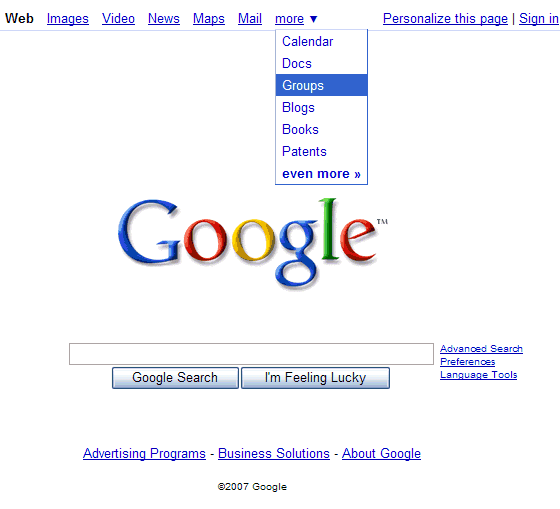
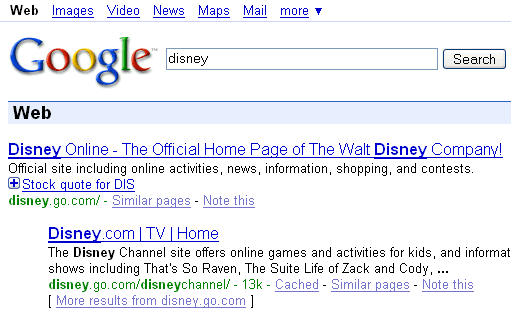
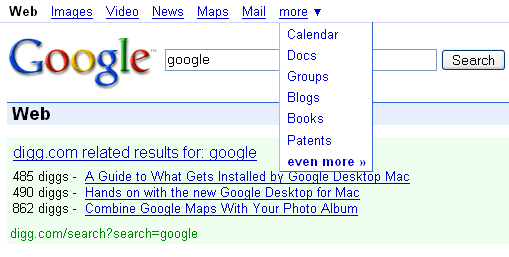
{ Thank you, Will Shepherdson. }



{ Thank you, Will Shepherdson. }
March 22, 2007
Summarizing Search Results
Search engines shows snippets next to each search results so you can decide if a page is relevant without visiting it first. But snippets are pretty short and focus on the text that includes your keywords. To find more about a page, a text summarizer that shows the key phrases would be helpful.
Syntatica is a company that combined search results with summarization and the results is Syntatica Search. If you leave behind the fact that Syntatica uses Live Search, you'll notice that the summary gives you a better idea about the content of a page than the snippet. This works well especially with pages that have a lot of content on a single topic.
"Unlike conventional search-and-retrieval programs, Syntactica does not simply match strings of letters to other strings of letters in an index. It analyzes concepts in the context of the sentence structures in which the words reside. (...) The program first determines the semantic weight of the concept from the dictionary. (...) After the semantic weight is determined, the program determines the concept's place in the text's syntactic structure to determine its overall relevance. Once a concept's relevance has been determined, the program follows more rules that compare the weight of all the concepts within a text, and generates summaries based on the relevance of all its concepts to produce the desired output."
This could be a machine-generated replacement of the meta description tag, that was mostly used to mislead search engines. It's the core essence of a page expressed using portions of the text.
The screenshot below shows a search result for [Twitter], a snippet generated by the search engine and an abstract produced by Syntatica.
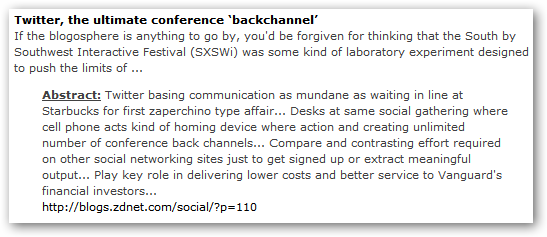
Syntatica is a company that combined search results with summarization and the results is Syntatica Search. If you leave behind the fact that Syntatica uses Live Search, you'll notice that the summary gives you a better idea about the content of a page than the snippet. This works well especially with pages that have a lot of content on a single topic.
"Unlike conventional search-and-retrieval programs, Syntactica does not simply match strings of letters to other strings of letters in an index. It analyzes concepts in the context of the sentence structures in which the words reside. (...) The program first determines the semantic weight of the concept from the dictionary. (...) After the semantic weight is determined, the program determines the concept's place in the text's syntactic structure to determine its overall relevance. Once a concept's relevance has been determined, the program follows more rules that compare the weight of all the concepts within a text, and generates summaries based on the relevance of all its concepts to produce the desired output."
This could be a machine-generated replacement of the meta description tag, that was mostly used to mislead search engines. It's the core essence of a page expressed using portions of the text.
The screenshot below shows a search result for [Twitter], a snippet generated by the search engine and an abstract produced by Syntatica.

Yahoo Widgets vs Google Desktop
Yahoo launched a new version of Yahoo Widgets (previously known as Konfabulator), a free application that displays small widgets on your desktop. Launched in 2002 for Mac, and then ported to Windows, Konfabulator was bought in 2005 by Yahoo.
Google Desktop was launched in 2004 as a desktop search tool, but it started to include support for widgets in 2005. "Google Desktop is a new, easier way to get information – even without searching. You can think of it as a personal web assistant that learns about your habits and interests to identify and present web pages, news stories, and photos that it thinks you will be interested in," said Marissa Mayer.
While Konfabulator is the real innovator, Google Desktop combined widgets with search and focused on personalization. Here's a small comparison table:
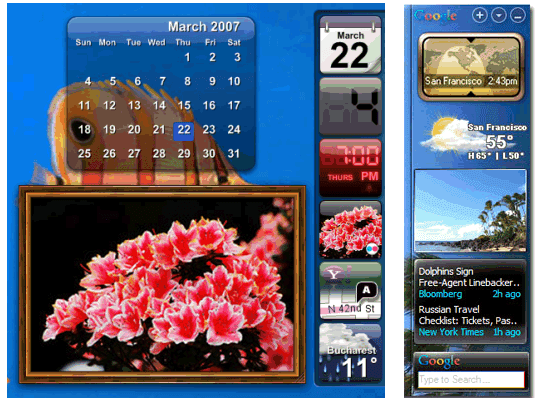
Yahoo Widgets is for people who want to spread a lot of information chaotically on the desktop; there are plenty of sleek widgets to choose from. Google Desktop is for organized people: it lets you search you computer as well as the web, it shows a sidebar that's visible all the time and personalizes the gadgets automatically.
Google Desktop was launched in 2004 as a desktop search tool, but it started to include support for widgets in 2005. "Google Desktop is a new, easier way to get information – even without searching. You can think of it as a personal web assistant that learns about your habits and interests to identify and present web pages, news stories, and photos that it thinks you will be interested in," said Marissa Mayer.
While Konfabulator is the real innovator, Google Desktop combined widgets with search and focused on personalization. Here's a small comparison table:
| | Google Desktop | Yahoo Widgets |
| Platforms | Windows 2000/XP/Vista | Mac OSX, Windows 2000/XP/Vista |
| Setup size | 1.7 MB | 11.6 MB |
| Terminology | gadgets | widgets |
| Default widgets | Gmail, clock, To Do list, news, feed reader, sticky notes, photos, weather. | Yahoo! search, maps, notepad, address book, mail, photos, Flickr, Calendar, Weather, Finance, digital clock, CPU monitor, widget gallery. |
| Total number of widgets | 360 | 3884 |
| Rendering | In the same process as Google Desktop. | Each widget has its own process: as a result, Yahoo Widgets is more stable, but also uses more memory. |
| Widgets are built in | XML and JavaScript | XML and JavaScript |
| What you can do with widgets |
|
|
| What's unique |
|
|
| Performance | Google Desktop also indexes your computer, so it has worse performance. If you disable desktop search functionality, you'll reduce memory usage. | The latest version improves memory usage. The performance is similar to Google Desktop without desktop search. |

Yahoo Widgets is for people who want to spread a lot of information chaotically on the desktop; there are plenty of sleek widgets to choose from. Google Desktop is for organized people: it lets you search you computer as well as the web, it shows a sidebar that's visible all the time and personalizes the gadgets automatically.
March 21, 2007
Picasa Web Albums API
The API has already been available unofficially, but starting today it's a reliable way to interact with Picasa Web Albums. The API lets you send or receive information formatted as GData feeds. After securely authenticating to Google, you can request all the albums and the photos from an album, create new albums, replace and delete photos, and also obtain search results.
Using the API, you can create a new interface for Picasa Web Albums, or you can let users upload photos to Picasa Web from your desktop or web application. Sven Mawson from Google offers more ideas: "Have a great idea for integrating your photos and tags into a semantic network? Want to add a slide show of your favorite photos to your homepage and include user comments? How about autotagging your photos based on image analysis or photo description or title?"
An interesting example is Picnik, which is a very nice online photo editor. Picnik imports photos from your computer, from Flickr, Picasa Web Albums, and search results. If you choose to import photos from Picasa Web, you'll enter your credentials (Picnik should use Google's authentication API), and select photos from your albums. After doing some basic editing (you can crop, resize, rotate, apply some filters), the photo can be saved to Picasa Web Albums, but it won't replace the original copy.
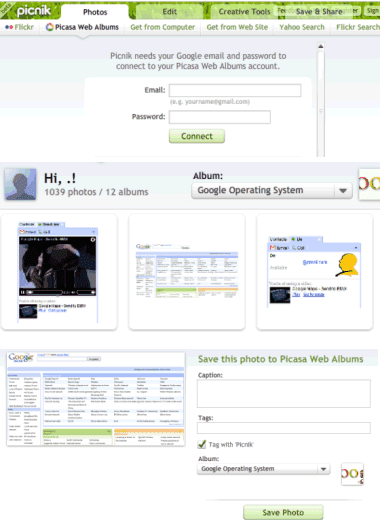
Another new API is for Google Notebook, but this one is limited to read-only access to public notebooks. As more Google applications get APIs, the data you store on Google's servers will become easier to access from other interfaces securely, easier to backup and more valuable.
Using the API, you can create a new interface for Picasa Web Albums, or you can let users upload photos to Picasa Web from your desktop or web application. Sven Mawson from Google offers more ideas: "Have a great idea for integrating your photos and tags into a semantic network? Want to add a slide show of your favorite photos to your homepage and include user comments? How about autotagging your photos based on image analysis or photo description or title?"
An interesting example is Picnik, which is a very nice online photo editor. Picnik imports photos from your computer, from Flickr, Picasa Web Albums, and search results. If you choose to import photos from Picasa Web, you'll enter your credentials (Picnik should use Google's authentication API), and select photos from your albums. After doing some basic editing (you can crop, resize, rotate, apply some filters), the photo can be saved to Picasa Web Albums, but it won't replace the original copy.

Another new API is for Google Notebook, but this one is limited to read-only access to public notebooks. As more Google applications get APIs, the data you store on Google's servers will become easier to access from other interfaces securely, easier to backup and more valuable.
On YouTube's Success
Deepak Thomas and Vineet Buch wrote an interesting about YouTube, titled "YouTube Case Study: Widget marketing comes of age". They explain the key factors that assured YouTube's success.
YouTube was launched when social networks started to become popular, when the bandwidth became cheaper and people wanted an interactive alternative to TV. But other sites did similar things, but couldn't have YouTube's success. I wonder why.
{ via Greg Linden. }
Online video definitely existed before YouTube came into vogue. However, uploading videos, sharing and watching them was quite cumbersome. (...) Video files were too large to be e-mailed. (...) Viewers would typically need to wait for the entire video to download before they could start watching it. This was a problem not limited to just peer-to-peer video sharing. Most professional websites with video content had the same issue. Downloading the video was just half the battle. Users needed to install the appropriate video player, the free versions of which often behaved like "spyware". (...)
Distributing popular and hard-to-find video clips was clearly a success factor. Clips of the popular, long-running television show, Saturday Night Live was a particularly significant example. (...)
YouTube allowed users to easily embed any hosted videos on web pages or blogs. This turned out to be particularly popular with social-networking websites, especially MySpace. (...)
While the technology platform used by YouTube was not particularly remarkable, it was designed to solve the problem at hand. The technology concept was to encode videos in the Macromedia Flash format and take advantage of the millions of computers which already had the Flash player installed on it.
YouTube was launched when social networks started to become popular, when the bandwidth became cheaper and people wanted an interactive alternative to TV. But other sites did similar things, but couldn't have YouTube's success. I wonder why.
{ via Greg Linden. }
March 20, 2007
Easter Egg in Google Personalized Homepage
There's an easter egg related to the new themes added in Google Personalized Homepage. If you chose any theme other than Bus Stop and Classic, visit the homepage at 3:14 AM (your local time)*.
In the Beach theme there's Nessie, the Loch Ness monster:
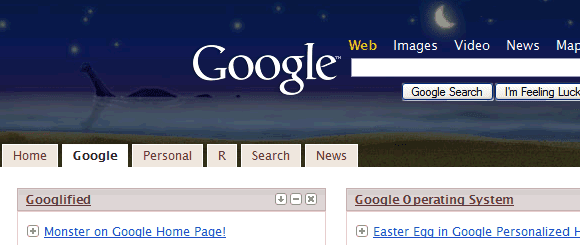
And the "Sweet dreams" theme has a nice Pi:

Tea house:
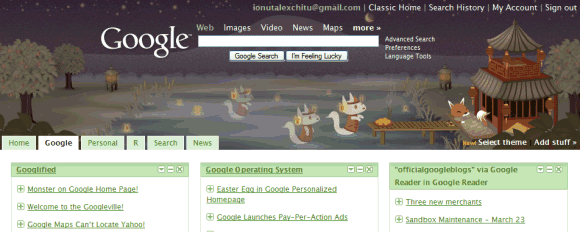
Seasonal scape:

City scape:
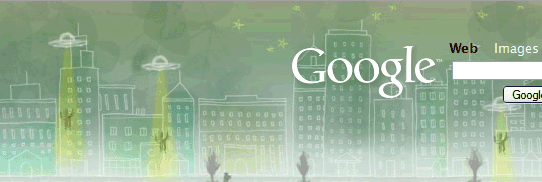
For a way to see these easter eggs, check Ben's comment. You'll have to select a theme and inject the content from the CSS file corresponding to your theme:
http://www.google.com/ig/skins/NAME/NAME_3.14am.css
where NAME is in { teahouse, cityscape, beach, sweetdreams, winterscape }
* As you might know, pi=3.14159...
In the Beach theme there's Nessie, the Loch Ness monster:

And the "Sweet dreams" theme has a nice Pi:

Tea house:

Seasonal scape:

City scape:

For a way to see these easter eggs, check Ben's comment. You'll have to select a theme and inject the content from the CSS file corresponding to your theme:
http://www.google.com/ig/skins/NAME/NAME_3.14am.css
where NAME is in { teahouse, cityscape, beach, sweetdreams, winterscape }
* As you might know, pi=3.14159...
Google Launches Pay-Per-Action Ads
After testing pay-per-action AdSense ads last year, Google officially launches the program (although it's limited to US advertisers).
"Pay-per-action advertising is a new pricing model that allows advertisers to pay only when specific actions that they define are completed by a user on their site. Rather than paying for clicks or impressions, advertisers can choose to pay when a user makes a purchase, signs up for a newsletter, or completes any other clearly defined action that they choose."
The new pay-per-action ads will have a format similar to the current AdSense referral blocks. "Publishers can choose to place specific pay-per-action ads in new ad units that they create, or allow us to serve the highest converting pay-per-action ads that are related to a topic that they choose."
Some facts:
* formats: text ads, image ads, embeddable links. The text and image referral ads are available in the same sizes as the existing image ad formats.
* ad scope: you can choose a keyword or a list of up to 15 products. Google will rotate the ads and try to display the best performing ones for a site.
The new ads are a departure from AdSense's philosophy of bringing contextual ads, but they give publishers more control over the products that are promoted. The ads can be endorsed, they're more expensive, but require more than a simple click. Visitors should buy a product, fill a form, register to a service, download a program, or perform other actions selected by the advertisers.
To sign up for the AdSense side of the service (you're a publisher), go to AdSense Referrals Beta. To sign up for the AdWords side of the service (you're an US advertiser), go to Google AdWords.
"Pay-per-action advertising is a new pricing model that allows advertisers to pay only when specific actions that they define are completed by a user on their site. Rather than paying for clicks or impressions, advertisers can choose to pay when a user makes a purchase, signs up for a newsletter, or completes any other clearly defined action that they choose."
The new pay-per-action ads will have a format similar to the current AdSense referral blocks. "Publishers can choose to place specific pay-per-action ads in new ad units that they create, or allow us to serve the highest converting pay-per-action ads that are related to a topic that they choose."
Some facts:
* formats: text ads, image ads, embeddable links. The text and image referral ads are available in the same sizes as the existing image ad formats.
* ad scope: you can choose a keyword or a list of up to 15 products. Google will rotate the ads and try to display the best performing ones for a site.
The new ads are a departure from AdSense's philosophy of bringing contextual ads, but they give publishers more control over the products that are promoted. The ads can be endorsed, they're more expensive, but require more than a simple click. Visitors should buy a product, fill a form, register to a service, download a program, or perform other actions selected by the advertisers.
To sign up for the AdSense side of the service (you're a publisher), go to AdSense Referrals Beta. To sign up for the AdWords side of the service (you're an US advertiser), go to Google AdWords.
Comparing Google and Yahoo in Mobile Search
On Yahoo Mobile homepage, Yahoo launched a challenge to compare its new mobile search engine with Google's. Yahoo recommends you to download a PDF [ 13.1 MB ] that compares the search results for 16 general queries like: "New York", "George Bush", "iPod".
Unlike Google, that only shows web search results by default (and occasionally OneBox results), Yahoo shows the first results from a lot of specialized search engines for some queries. They call this "Yahoo oneSearch" (video) and it's the major feature of their new search engine.
Yahoo explains: "oneSearch results are delivered to you in a new, breakthrough format that redefines search for the mobile phone. It's all about getting instant answers with just one click—no need to sift through a bunch of links to find exactly what you're looking for. (...) oneSearch results are easy to read, scroll through, and expand when you want more information—like more images to view—with a single click. You don't have to "feel lucky" to be lucky every time with oneSearch."
I would argue that anything would be good to answer a such a general query like "New York" and Yahoo should've focused on more precise queries in their report. In fact, for most queries, Yahoo Mobile Search shows 3 web pages and 3 mobile web pages, while Google shows 10 web pages - that means Google shows more information and focuses on web pages, which are more numerous and more interesting than mobile web pages (compare the results for [Oscars 2007] in Yahoo and Google).
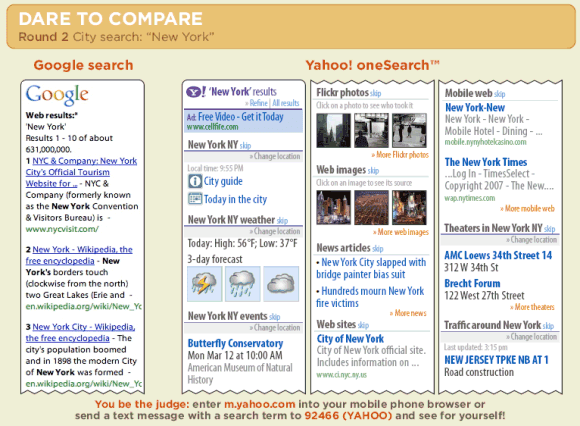
{ Thank you, Alexandru Dragan. }
Unlike Google, that only shows web search results by default (and occasionally OneBox results), Yahoo shows the first results from a lot of specialized search engines for some queries. They call this "Yahoo oneSearch" (video) and it's the major feature of their new search engine.
Yahoo explains: "oneSearch results are delivered to you in a new, breakthrough format that redefines search for the mobile phone. It's all about getting instant answers with just one click—no need to sift through a bunch of links to find exactly what you're looking for. (...) oneSearch results are easy to read, scroll through, and expand when you want more information—like more images to view—with a single click. You don't have to "feel lucky" to be lucky every time with oneSearch."
I would argue that anything would be good to answer a such a general query like "New York" and Yahoo should've focused on more precise queries in their report. In fact, for most queries, Yahoo Mobile Search shows 3 web pages and 3 mobile web pages, while Google shows 10 web pages - that means Google shows more information and focuses on web pages, which are more numerous and more interesting than mobile web pages (compare the results for [Oscars 2007] in Yahoo and Google).

{ Thank you, Alexandru Dragan. }
March 19, 2007
Themes for Google Personalized Homepage
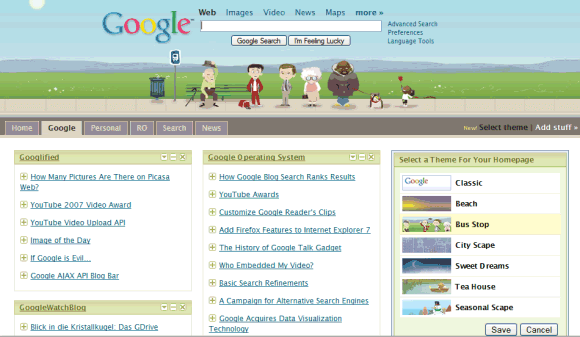
Google Personalized Homepage becomes a little bit more "customizable". Now you can select between the default theme and six other childish themes. Themes change the background, text colors, icons, Google's logo, button sizes and more.
The theme is actually an XML that contains a list of CSS files. Google says that the "theme will dynamically change to match your time of day, including local sunrise and sunset times", so you have to enter your location. If you look in the XML, you'll notice a lot of references to the weather, so it's likely that the theme will change depending on weather, as well.
Because the theme is actually just a CSS file (and its dependencies), Google could let users build their own themes and maybe even host those themes to improve the performance.
{ Thank you, Allen Fuqua. }
How Google Blog Search Ranks Results
Unlike most blog search engines, Google Blog Search ranks the results by relevancy. You can change that by clicking on "sort by date", but the default option is useful if you want to find the most significant blog posts about a topic. But how does Google rank blog posts?
A new patent gives us some answers. Google uses indicators to reflect the quality of a blog or of a blog post.
To rank the search results, Google combines a quality score obtained by mixing those signals with a relevance score (IR score) that depends on the query. "The IR score may be determined based on the number of occurrences of the search terms in the document. The IR score may be determined based on where the search terms occur within the document (e.g., title, content, etc.) or characteristics of the search terms (e.g., font, size, color, etc.). A search term may be weighted differently from another search term when multiple search terms are present. The proximity of the search terms when multiple search terms are present may influence the IR score." (the quote was slightly altered for clarity)
We learned that Google uses all kinds of factors to determine the popularity and the quality of a blog, but that doesn't mean less popular blogs are left out if they have relevant content. You should also try to avoid all the negative signals that may indicate your blog is spammy.
{ via Search Engine Roundtable }
A new patent gives us some answers. Google uses indicators to reflect the quality of a blog or of a blog post.
| Positive signals | Negative signals (spam signals) |
|
|
To rank the search results, Google combines a quality score obtained by mixing those signals with a relevance score (IR score) that depends on the query. "The IR score may be determined based on the number of occurrences of the search terms in the document. The IR score may be determined based on where the search terms occur within the document (e.g., title, content, etc.) or characteristics of the search terms (e.g., font, size, color, etc.). A search term may be weighted differently from another search term when multiple search terms are present. The proximity of the search terms when multiple search terms are present may influence the IR score." (the quote was slightly altered for clarity)
We learned that Google uses all kinds of factors to determine the popularity and the quality of a blog, but that doesn't mean less popular blogs are left out if they have relevant content. You should also try to avoid all the negative signals that may indicate your blog is spammy.
{ via Search Engine Roundtable }
YouTube Awards
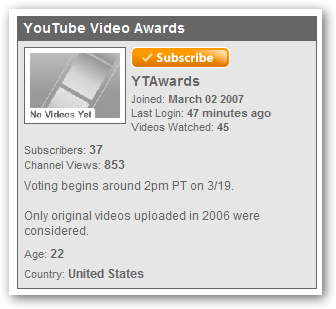
Associated Press reports that YouTube will hold the first video awards from its short history this week. Users will be able to vote for the best original videos uploaded in 2006 at a special YouTube channel.
"YouTube community members can vote on their favorites beginning Monday and concluding on Friday. The winners, as chosen by the community, will be announced March 25. Each will be prominently featured on YouTube and receive a trophy, the design of which will be revealed later."
The nominees include Internet video stars Lonelygirl15 and "Ask a Ninja" and these awards are an opportunity to give them an official recognition and a big "thank you" for contributing to YouTube's success.
Here are the nominees (via NewTeeVee):
Update: And the winners are...
Customize Google Reader's Clips
Google Reader lets you tag blogs and blog posts and share those items with your friends. You get a feed, a web page and a widget you can add to your site.
If you use Google Reader's code, you'll only be able to show the titles of the most recent items and a link to the source. Fortunately, Google Reader has a JSON API, so you can use the callback parameter to create a JavaScript function that adds more features.
1. Make a tag public
Go to Settings/Tags and click on the broadcasting icon next to the tag you want to make public. You can also customize the clips for shared items, which are already public.
2. Get the code
Click on "add a clip to your site", choose the "None" color scheme, select the number of items you want to display and copy the code.
The code will look like this:
<script type="text/javascript" src="http://www.google.com/reader/ui/publisher-en.js"></script>
<script type="text/javascript" src="http://www.google.com/reader/public/javascript/user/13577231804381328821/label/ex-googlers?n=5&callback=CODE"></script>
You can drop the first script element, because it's not necessary. The second script element will be customized below.
3. Customize the callback function
You'll notice that the second script calls an URL that has a "callback" parameter. You need to place the name of a JavaScript function with a single parameter - a Google Reader object that has more fields. The most important field is "items", an array that has the following structure:
"items": [
{
"title": "Blog title",
"published": 1173471960,
"updated": 1173481776,
"alternate": {
"href": "http://blogname.blogspot.com/2007/03/test.html",
"type": "text/html"
},
"content": "The first words from the post...",
"annotations": [
{
"content": "\"This is a very interesting post.\"",
"author": "Daniel",
"userId": "13377231804381328721",
"profileId": "125880905881548216826"
}
],
"author": "Dan Bush",
"origin": {
"streamId": "user/13377231804381328721/source/com.google/link",
"title": "Dan's Blog",
"htmlUrl": "http://blogname.blogspot.com"
}
},
....
]
A simple example of a callback function is buildContent, which requires a div element that has the ID "container", where it will place your clip:
function buildContent (blog) {
if (!blog || !blog.items) return;
var container=document.getElementById("container");
var code="";
for (var i = 0; i < blog.items.length; i++) {
var item = blog.items[i];
code=code + "<a href='"+item.alternate.href+"'>"+ item.title+ "</a><div>"+ item.content+"</div><br />";
}
container.innerHTML=code;
}
You'll need to change the callback parameter in the code obtained from Google Reader.
http://www.google.com/reader/public/javascript/
user/[id]/label/labelname?n=5&callback=buildContent
It's easy to customize your content by using CSS because you build the text displayed in your site. To show only the posts from a blog, subscribe to the blog in Google Reader and add it to a new folder.
Here's a very basic page that uses this code.
If you use Google Reader's code, you'll only be able to show the titles of the most recent items and a link to the source. Fortunately, Google Reader has a JSON API, so you can use the callback parameter to create a JavaScript function that adds more features.
1. Make a tag public
Go to Settings/Tags and click on the broadcasting icon next to the tag you want to make public. You can also customize the clips for shared items, which are already public.
2. Get the code
Click on "add a clip to your site", choose the "None" color scheme, select the number of items you want to display and copy the code.
The code will look like this:
<script type="text/javascript" src="http://www.google.com/reader/ui/publisher-en.js"></script>
<script type="text/javascript" src="http://www.google.com/reader/public/javascript/user/13577231804381328821/label/ex-googlers?n=5&callback=CODE"></script>
You can drop the first script element, because it's not necessary. The second script element will be customized below.
3. Customize the callback function
You'll notice that the second script calls an URL that has a "callback" parameter. You need to place the name of a JavaScript function with a single parameter - a Google Reader object that has more fields. The most important field is "items", an array that has the following structure:
"items": [
{
"title": "Blog title",
"published": 1173471960,
"updated": 1173481776,
"alternate": {
"href": "http://blogname.blogspot.com/2007/03/test.html",
"type": "text/html"
},
"content": "The first words from the post...",
"annotations": [
{
"content": "\"This is a very interesting post.\"",
"author": "Daniel",
"userId": "13377231804381328721",
"profileId": "125880905881548216826"
}
],
"author": "Dan Bush",
"origin": {
"streamId": "user/13377231804381328721/source/com.google/link",
"title": "Dan's Blog",
"htmlUrl": "http://blogname.blogspot.com"
}
},
....
]
A simple example of a callback function is buildContent, which requires a div element that has the ID "container", where it will place your clip:
function buildContent (blog) {
if (!blog || !blog.items) return;
var container=document.getElementById("container");
var code="";
for (var i = 0; i < blog.items.length; i++) {
var item = blog.items[i];
code=code + "<a href='"+item.alternate.href+"'>"+ item.title+ "</a><div>"+ item.content+"</div><br />";
}
container.innerHTML=code;
}
You'll need to change the callback parameter in the code obtained from Google Reader.
http://www.google.com/reader/public/javascript/
user/[id]/label/labelname?n=5&callback=buildContent
It's easy to customize your content by using CSS because you build the text displayed in your site. To show only the posts from a blog, subscribe to the blog in Google Reader and add it to a new folder.
Here's a very basic page that uses this code.
March 18, 2007
Add Firefox Features to Internet Explorer 7
Here are some Internet Explorer 7 add-ons that mimic some useful features from Firefox that aren't available in Microsoft's browser (and sometimes add more features).
Inline search - search the current page as you type. It only works with Ctrl+F.
ieSpell - spell checker. Unlike the spell checker from Firefox, you need to press a button before seeing the misspellings.
IE7Pro - adds many features available in popular Firefox extensions. You get crash recovery, ads filter (with a dumb predefined list), mouse gestures, an option to change the user agent plus some tweaks like moving the menu on top and removing the search box.
Feed Folder - similar to the Live Bookmarks from Firefox.
Developer toolbar - explore the DOM of a web page, locate and outline some elements in a page.
Inline search - search the current page as you type. It only works with Ctrl+F.
ieSpell - spell checker. Unlike the spell checker from Firefox, you need to press a button before seeing the misspellings.
IE7Pro - adds many features available in popular Firefox extensions. You get crash recovery, ads filter (with a dumb predefined list), mouse gestures, an option to change the user agent plus some tweaks like moving the menu on top and removing the search box.
Feed Folder - similar to the Live Bookmarks from Firefox.
Developer toolbar - explore the DOM of a web page, locate and outline some elements in a page.
The History of Google Talk Gadget
The history of the Google Talk gadget started in November 2005, when Wes and Dudley Carr launched Gtalkr. Before Gtalkr, they had built Gush, a cross-platform Jabber instant messenger written in Flash and Python, that had a news reader and a free-flow layout. Back to Gtalkr:
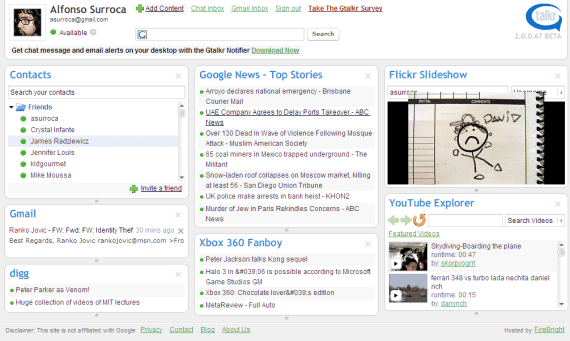
GTalkr grew and started to add the features of a personalized homepage: feeds, Flickr slideshows, YouTube viewer. But this personalized homepage was built in Flash and the widgets interacted with the IM client, so you could share blog posts or videos with your Google Talk contacts by simply dragging them from the widget to the IM client. Gtalkr attracted a lot of enthusiasts and it was pretty difficult to keep the service running.
In the meantime, Google launched Gmail chat and started to improve its Ajax personalized homepage. Other web-based instant messengers like Meebo became more and more popular, because they were convenient and weren't blocked by firewalls.
In May 2006, Google hired the two developers behind Gtalkr and the site has been taken down. They now work at Google's Kirkland office, where Google Talk is being developed, and bring back some of the features of Gtalkr. Google Talk gadget, which is one of the first things developed in Flash at Google (along with Google Video and Google Finance charts), can be added to any site, but doesn't have a way to interact with external content.
{ Screenshot licensed as Creative Commons by ASurroca. }
Gtalkr is a web-based IM client that communicates with the Google Talk service. There are a couple of things that stand out about Gtalkr aside from that fact that it's web-based. First, it incorporates indexing and searching of conversations. Second, Gtalkr is an IM client at heart, but it's meant to tie into other webservices such as Yahoo! maps. The Yahoo! maps example doesn't integrate into the presence and messaging infrastructure at the moment, but the capability is there. Flash developers will be able to add their own extensions that can make use of our and Google's infrastructure.

GTalkr grew and started to add the features of a personalized homepage: feeds, Flickr slideshows, YouTube viewer. But this personalized homepage was built in Flash and the widgets interacted with the IM client, so you could share blog posts or videos with your Google Talk contacts by simply dragging them from the widget to the IM client. Gtalkr attracted a lot of enthusiasts and it was pretty difficult to keep the service running.
In the meantime, Google launched Gmail chat and started to improve its Ajax personalized homepage. Other web-based instant messengers like Meebo became more and more popular, because they were convenient and weren't blocked by firewalls.
In May 2006, Google hired the two developers behind Gtalkr and the site has been taken down. They now work at Google's Kirkland office, where Google Talk is being developed, and bring back some of the features of Gtalkr. Google Talk gadget, which is one of the first things developed in Flash at Google (along with Google Video and Google Finance charts), can be added to any site, but doesn't have a way to interact with external content.
{ Screenshot licensed as Creative Commons by ASurroca. }
Who Embedded My Video?
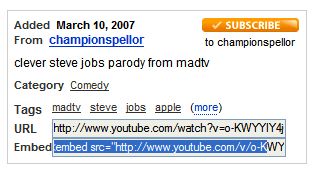
Let's say you upload a video to a site like YouTube and you want to see who viewed your video and where. An important number of views come from other sites that embed your video or link to it. You can use Google Blog Search to find them.
Find links to the video
A YouTube video has an address like: http://www.youtube.com/watch?v=o-KWYYIY4jQ. Paste the address in Google Blog Search and you'll find blogs and forums that link to the video.
Find sites that embed the video
You'll need to look at the code that needs to be added to a site and note the address included there: embed src="ADDRESS". For YouTube, this is a small alteration of the previous address and is similar to: http://www.youtube.com/v/o-KWYYIY4jQ. Now that you have the address of the embeddable Flash object, paste it in Google Blog Search and find a list of blogs.
An easier to find both kinds of blogs is to go to Technorati and to type the address of the video, but this only works for YouTube, while Google's Blog Search works for other sites too.